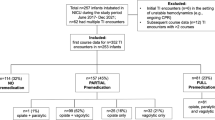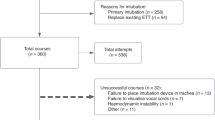Abstract
Objective:
The aim of this study was to analyze clinical characteristics of rocuronium as premedication for nonemergent intubation in infants.
Study Design:
Preterm infants requiring nonemergent intubation were randomized to receive atropine and fentanyl with or without rocuronium. Outcomes, patient characteristics and intubator's experience were noted. Onset, duration and degree of clinical paralysis were recorded for rocuronium group and for older infants receiving rocuronium per unit protocol.
Result:
Forty-four intubations were randomized (20 rocuronium, 24 control). Groups were similar in chronological and corrected gestational age, weight and intubator's experience. Successful intubation on first attempt was achieved in 35% of intubations under rocuronium vs 8% of controls; rocuronium was the only significant variable by logistic regression (odds ratio=0.052, P=0.029). Complete paralysis was reported in 80% of 57 rocuronium intubations; onset ranged from 14 to 178 s (65.9±43.4), and duration from 1 to 60 min (16.3±13.5).
Conclusion:
Rocuronium facilitated successful intubation and provided clinical paralysis quickly in most infants.
This is a preview of subscription content, access via your institution
Access options
Subscribe to this journal
Receive 12 print issues and online access
$259.00 per year
only $21.58 per issue
Buy this article
- Purchase on Springer Link
- Instant access to full article PDF
Prices may be subject to local taxes which are calculated during checkout


Similar content being viewed by others
References
Kelly MA, Finer NN . Nasotracheal intubation in the neonate: physiologic responses and effects of atropine and pancuronium. J Pediatr 1984; 105: 303–309.
Friesen RH, Honda AT, Thieme RE . Changes in anterior fontanel pressure in preterm neonates during tracheal intubation. Anesth Analg 1987; 66: 874–878.
Stow PJ, Mcleod ME, Burrows FA, Creighton RE . Anterior fontanelle pressure response to tracheal intubation in the awake and anaesthetized infant. Br J Anaesth 1988; 60: 167–170.
Simon L, Trifa M, Mokhtari M, Hamza J, Treluyer J . Premedication for tracheal intubation: a prospective survey in 75 neonatal and pediatric intensive care units. Crit Care Med 2004; 32 (2): 565–568.
Barrington KJ, Finer NN, Etches PC . Succinylcholine and atropine for premedication of the newborn infant before nasotracheal intubation: a randomized, controlled trial. Crit Care Med 1989; 17 (12): 1293–1296.
Leone TA, Rich W, Finer NN . Neonatal intubation: success of pediatric trainees. J Pediatr 2005; 146: 638–641.
Kumar P, Denson SE, Mancuso TJ, American Academy of Pediatrics Committee on Fetus and Newborn, Section on Anesthesiology and Pain Medicine. Clinical report—premedication for nonemergency endotracheal intubation in the neonate. Pediatrics 2010; 125 (3): 608–615.
Oei J, Hari R, Buth T, Lui K . Facilitation of neonatal nasotracheal intubation with premedication: a randomized controlled trial [abstract]. J Paediatr Child Health 2002; 38 (2): 146.
Barrington KJ, Byrne PJ . Premedication for neonatal intubation. Am J Perinatol 1998; 15 (4): 213–216.
Roberts KD, Leone TA, Edwards WH, Rich WD, Finer NN . Premedication for nonemergent neonatal intubations: a randomized, controlled trial comparing atropine and fentanyl to atropine, fentanyl and mivacurium. Pediatrics 2006; 118 (4): 1583–1591.
Dempsey EM, Al Hazzani F, Faucher D, Barrington KJ . Facilitation of neonatal endotracheal intubation with mivacurium and fentanyl in the neonatal intensive care unit. Arch Dis Child Fetal Neonatal Ed 2006; 91: 279–282.
Driessen JJ, Robertson EN, Booij LHDJ . Acceleromyography in neonates and small infants: baseline calibration and recovery of the responses after neuromuscular blockade with rocuronium. Eur J Anaesthesiol 2005; 22: 11–15.
Rapp HJ, Altenmueller CA, Waschke C . Neuromuscular recovery following rocuronium bromide single dose in infants. Paediatr Anaesth 2004; 14: 329–335.
Ziegler JW, Todres ID . Intubation of newborns [letter]. Am J Dis Child 1992; 146: 148–149.
Hancock S, Newell S, Brierley J, Berry A . Premedication for neonatal intubation: current practice in Australia and the United Kingdom [letter]. Arch Dis Child Fetal Neonatal Ed 2000; 83 (1): F74.
Whyte S, Birrell G, Wyllie J . Premedication before intubation in UK neonatal units. Arch Dis Child Fetal Neonatal Ed 2000; 82 (1): F38–F41.
Sarkar S, Schumacher RE, Baumgart S, Donn SM . Are newborns receiving premedication before elective intubation? J Perinatol 2006; 26: 286–289.
Ron M . Rapid-sequence intubation comes of age [editorial]. Ann Emerg Med 1996; 28 (1): 79–81.
Gerardi MJ, Sacchetti AD, Cantor RM, Santamaria JP, Sausche M, Lucid W et al. Rapid-sequence intubation of the pediatric patient. Ann Emerg Med 1996; 28 (1): 55–74.
Cantineau JP, Tazarourte K, Merckx P, Martin L, Reynaud P, Berson C et al. [Tracheal intubation in prehospital resuscitation: importance of rapid-sequence induction anesthesia]. Annales Francaises d Anesthesie et de Reanimation 1997; 16 (7): 878–884 (English abstract in Ovid).
Reynolds SF, Heffner J . Airway management of the critically ill patient. Chest 2005; 127 (4): 1397–1412.
Gnauck K, Lungo JB, Scalzo A, Peter J, Nakanishi A . Emergency intubation of the pediatric medical patient: use of anesthetic agents in the emergency department. Ann Emerg Med 1994; 23 (6): 1242–1247.
Duncan HP, Zurick NJ, Wolf AR . Should we reconsider awake neonatal intubation? A review of the evidence and treatment strategies. Paediatr Anaesth 2001; 11: 135–145.
Shah V, Ohlsson A . The effectiveness of premedication for endotracheal intubation in mechanically ventilated neonates: a systematic review. Clin Perinatol 2002; 29: 535–554.
Byrne E, MacKinnon R . Should premedication be used for semi-urgent or elective intubation in neonates? Arch Dis Child 2006; 91: 79–83.
Millar C, Bissonnette B . Awake intubation increases intracranial pressure without affecting cerebral blood flow velocity in infants. Can J Anaesth 1994; 41 (4): 281–287.
Friesen RH, Honda AT, Thieme RE . Changes in anterior fontanel pressure in preterm neonates during tracheal intubation. Anesth Analg 1987; 66: 874–878.
Marshall TA, Deeder R, Pai S, Berkowitz GP, Austin TL . Physiologic changes associated with endotracheal intubation in preterm infants. Crit Care Med 1984; 12 (6): 501–503.
Pokela ML, Koivisto M . Physiological changes, plasma B-endorphin and cortisol responses to tracheal intubation in neonates. Acta Paediatr 1994; 83: 151–156.
Driessen JJ, Robertson EN, Van Egmond J, Booij LHDJ . Time course of action of rocuronium 0.3 mg/kg in children with and without endstage renal failure. Paediatr Anaesth 2002; 12 (6): 507–510.
Kaplan RF, Uejima T, Lobel G, Goudsouzian N, Ginsberg B, Hannallah R et al. Intramuscular rocuronium in infants and children: a multicenter study to evaluate tracheal intubating conditions, onset, and duration of action. Anesthesiology 1999; 91: 633–638.
Reynolds LM, Lau M, Brown R, Luks A, Sharma M, Fisher D . Bioavailability of intramuscular rocuronium in infants and children. Anesthesiology 1997; 87 (5): 1096–1105.
Saldien V, Vermeyen KM, Wuyts FL . Target-controlled infusion of rocuronium in infants, children, and adults: a comparison of the pharmacokinetic and pharmacodynamic relationship. Anesth Analg 2003; 97: 44–49.
Oh AY, Seo KS, Goo EK, Park O, Kim SJ, Kim JH . Prevention of withdrawal movement associated with injection of rocuronium in children: comparison of remifentanil, alfentanil and fentanyl. Acta Aneaesthesiologica Scandanavia 2007; 51 (9): 1190–1193.
Acknowledgements
We appreciate the cooperation of the nurses, respiratory therapists, and Ms Bonnie Kanzia of the Neonatal Intensive Care Unit of Loyola University Medical Center in completing our study. We especially thank the parents who allowed us to include their children in our research.
Author information
Authors and Affiliations
Corresponding author
Ethics declarations
Competing interests
The authors declare no conflict of interest.
Rights and permissions
About this article
Cite this article
Feltman, D., Weiss, M., Nicoski, P. et al. Rocuronium for nonemergent intubation of term and preterm infants. J Perinatol 31, 38–43 (2011). https://doi.org/10.1038/jp.2010.74
Received:
Revised:
Accepted:
Published:
Issue Date:
DOI: https://doi.org/10.1038/jp.2010.74
Keywords
This article is cited by
-
Standardizing premedication for non-emergent neonatal tracheal intubations improves compliance and patient outcomes
Journal of Perinatology (2022)
-
Premedication with neuromuscular blockade and sedation during neonatal intubation is associated with fewer adverse events
Journal of Perinatology (2019)
-
Moving from controversy to consensus: premedication for neonatal intubation
Journal of Perinatology (2018)
-
Effect of premedication regimen on infant pain and stress response to endotracheal intubation
Journal of Perinatology (2015)
-
Assessment of atropine-sufentanil-atracurium anaesthesia for endotracheal intubation: an observational study in very premature infants
BMC Pediatrics (2014)



